MITSUBISHI OUTLANDER SPORT 2014 3.G Owners Manual
Manufacturer: MITSUBISHI, Model Year: 2014, Model line: OUTLANDER SPORT, Model: MITSUBISHI OUTLANDER SPORT 2014 3.GPages: 388, PDF Size: 20.04 MB
Page 101 of 388
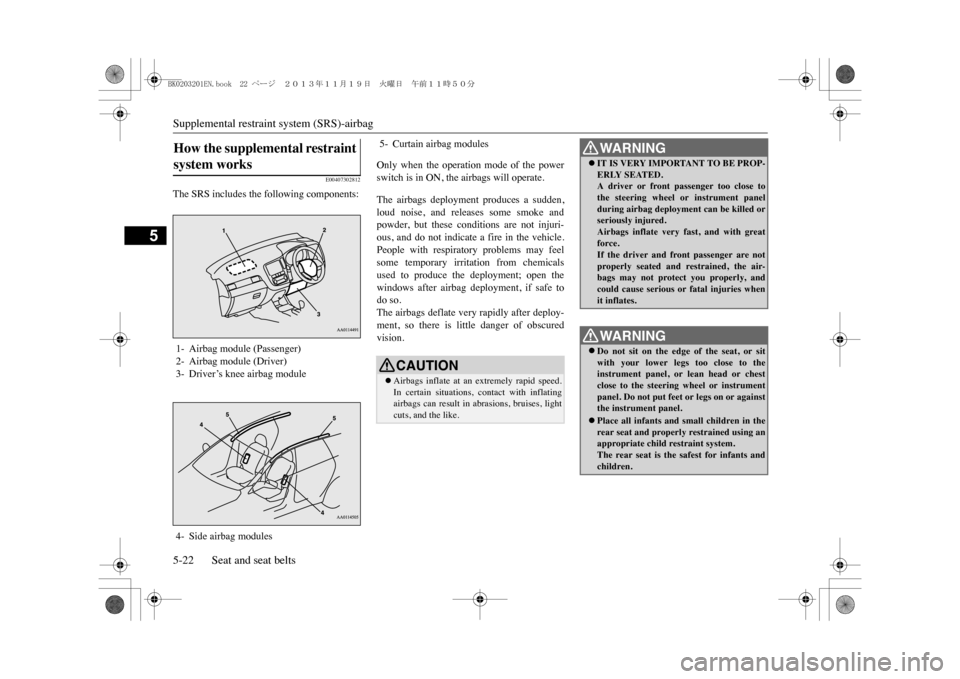
Supplemental restrain
t system (SRS)-airbag
5-22 Seat and seat belts
5
E00407302812
The SRS includes the following components:
Only when the operation mode of the powerswitch is in ON, the airbags will operate.The airbags deployment produces a sudden,loud noise, and releases some smoke andpowder, but these conditions are not injuri-ous, and do not indicate a fire in the vehicle.People with respiratory problems may feelsome temporary irritation from chemicalsused to produce the deployment; open thewindows after airbag deployment, if safe todo so.The airbags deflate very rapidly after deploy-ment, so there is little danger of obscuredvision.
How the supplemental restraint system works 1- Airbag module (Passenger)2- Airbag module (Driver)3- Driver’s knee airbag module4- Side airbag modules
5- Curtain airbag modules
CAUTION�zAirbags inflate at an extremely rapid speed.In certain situations, contact with inflatingairbags can result in abrasions, bruises, lightcuts, and the like.
WA R N I N G�zIT IS VERY IMPORTANT TO BE PROP-ERLY SEATED.A driver or front passenger too close tothe steering wheel or instrument panelduring airbag deployment can be killed orseriously injured.Airbags inflate very
fast, and with great
force.If the driver and front passenger are notproperly seated and restrained, the air-bags may not protect you properly, andcould cause serious or fatal injuries whenit inflates.WA R N I N G�zDo not sit on the edge
of the seat, or sit
with your lower legs too close to theinstrument panel, or lean head or chestclose to the steering wheel or instrumentpanel. Do not put feet or legs on or againstthe instrument panel.�zPlace all infants and small children in therear seat and properly restrained using anappropriate child restraint system.The rear seat is the safest for infants andchildren.
BK0203201EN.book 22 ページ 2013年11月19日 火曜日 午前11時50分
Page 102 of 388
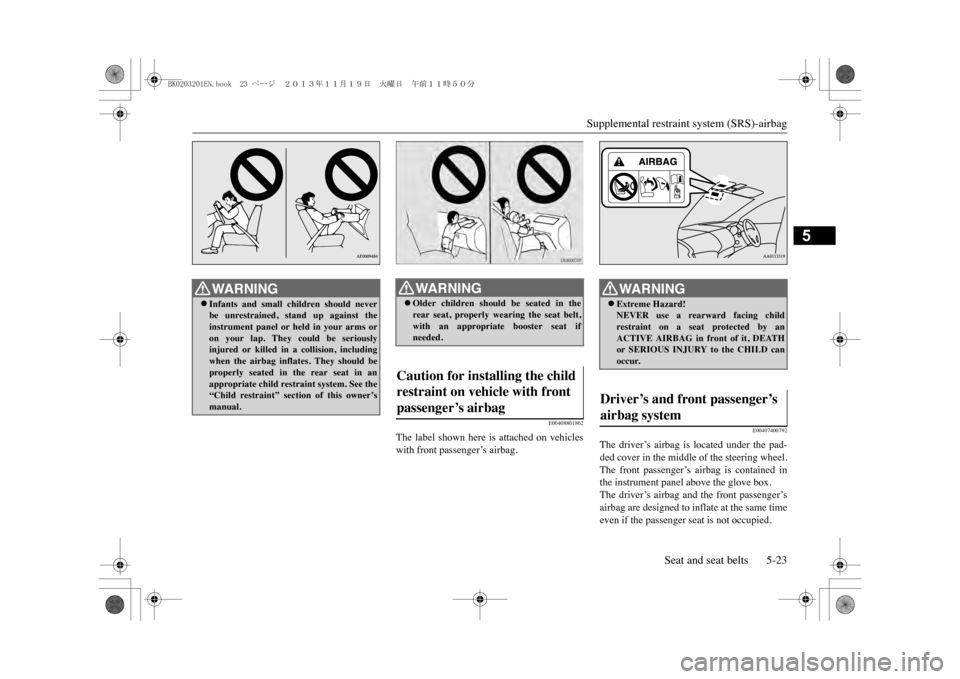
Supplemental restraint system (SRS)-airbag
Seat and seat belts 5-23
5
E00408801862
The label shown here is attached on vehicleswith front passenger’s airbag.
E00407400792
The driver’s airbag is located under the pad-ded cover in the middle of the steering wheel.The front passenger’s airbag is contained inthe instrument panel above the glove box.The driver’s airbag and the front passenger’sairbag are designed to inflate at the same timeeven if the passenger seat is not occupied.
WA R N I N G�zInfants and small children should neverbe unrestrained,
stand up against the
instrument panel or held in your arms oron your lap. They could be seriouslyinjured or killed in a collision, includingwhen the airbag inflat
es. They should be
properly seated in the rear seat in anappropriate child restraint system. See the“Child restraint” section of this owner’smanual.
WA R N I N G�zOlder children should be seated in therear seat, properly wearing the seat belt,with an appropriate booster seat ifneeded.
Caution for installing the child restraint on vehicle with front passenger’s airbag
WA R N I N G�zExtreme Hazard!NEVER use a rearward facing childrestraint on a seat protected by anACTIVE AIRBAG in front of it, DEATHor SERIOUS INJURY to the CHILD canoccur.
Driver’s and front passenger’s airbag system
BK0203201EN.book 23 ページ 2013年11月19日 火曜日 午前11時50分
Page 103 of 388
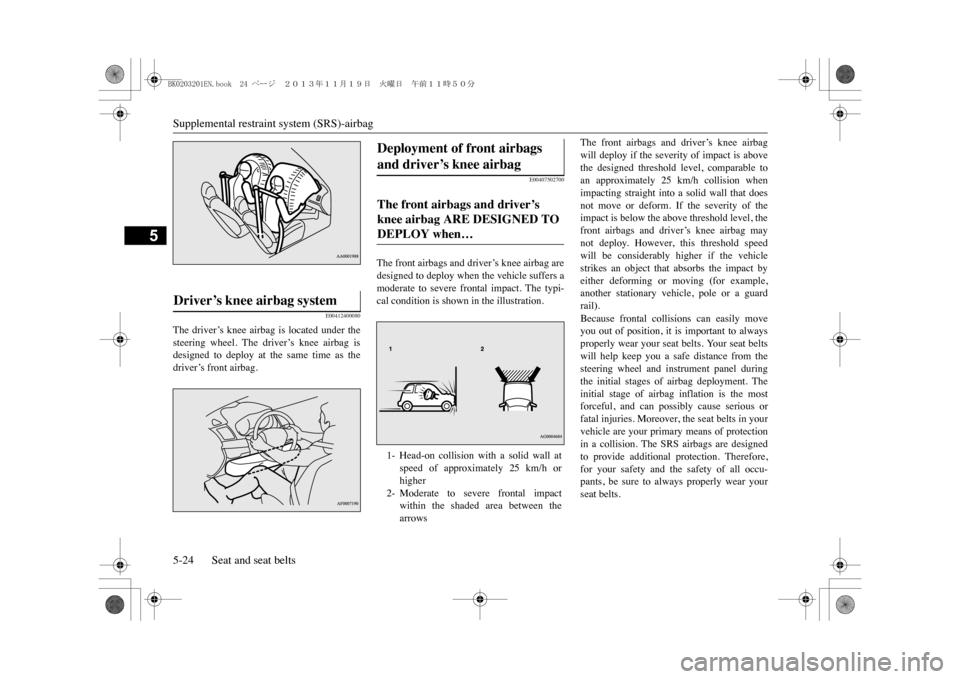
Supplemental restrain
t system (SRS)-airbag
5-24 Seat and seat belts
5
E00412400080
The driver’s knee airbag is located under thesteering wheel. The driver’s knee airbag isdesigned to deploy at the same time as thedriver’s front airbag.
E00407502700
The front airbags and driver’s knee airbag aredesigned to deploy when the vehicle suffers amoderate to severe frontal impact. The typi-cal condition is shown in the illustration.
The front airbags and driver’s knee airbagwill deploy if the severity of impact is abovethe designed threshold level, comparable toan approximately 25 km/h collision whenimpacting straight into a solid wall that doesnot move or deform. If the severity of theimpact is below the above threshold level, thefront airbags and driver’s knee airbag maynot deploy. However, this threshold speedwill be considerably higher if the vehiclestrikes an object that absorbs the impact byeither deforming or moving (for example,another stationary vehicle, pole or a guardrail).Because frontal collisions can easily moveyou out of position, it is important to alwaysproperly wear your seat belts. Your seat beltswill help keep you a safe distance from thesteering wheel and instrument panel duringthe initial stages of airbag deployment. Theinitial stage of airbag inflation is the mostforceful, and can possibly cause serious orfatal injuries. Moreover, the seat belts in yourvehicle are your primary means of protectionin a collision. The SRS airbags are designedto provide additional protection. Therefore,for your safety and the safety of all occu-pants, be sure to always properly wear yourseat belts.
Driver’s knee airbag system
Deployment of front airbags and driver’s knee airbag The front airbags and driver’s knee airbag ARE DESIGNED TO DEPLOY when… 1- Head-on collision with a solid wall at
speed of approximately 25 km/h orhigher
2- Moderate to severe frontal impact
within the shaded area between thearrows
BK0203201EN.book 24 ページ 2013年11月19日 火曜日 午前11時50分
Page 104 of 388
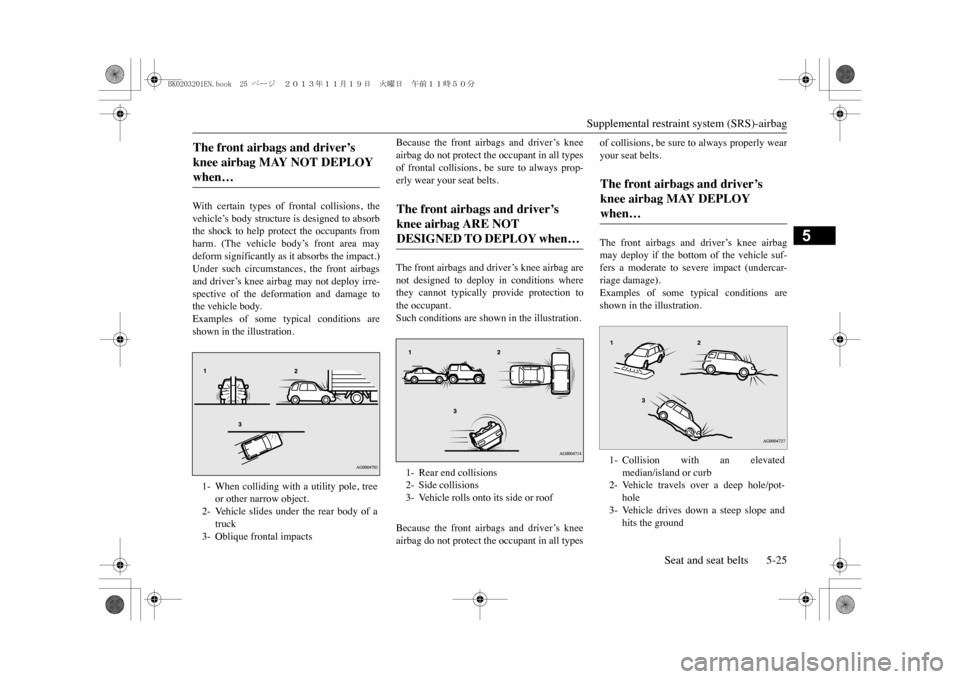
Supplemental restraint system (SRS)-airbag
Seat and seat belts 5-25
5
Wi t h ce r ta i n ty pe s o f f r o nt al col l i s i on s , t h evehicle’s body structure is designed to absorbthe shock to help protect the occupants fromharm. (The vehicle body’s front area maydeform significantly as it absorbs the impact.)Under such circumstances, the front airbagsand driver’s knee airbag may not deploy irre-spective of the deformation and damage tothe vehicle body.Examples of some typical conditions areshown in the illustration.
Because the front airbags and driver’s kneeairbag do not protect the occupant in all typesof frontal collisions, be sure to always prop-erly wear your seat belts.The front airbags and driver’s knee airbag arenot designed to deploy in conditions wherethey cannot typically provide protection tothe occupant.Such conditions are shown in the illustration.Because the front airbags and driver’s kneeairbag do not protect the occupant in all types
of collisions, be sure to always properly wearyour seat belts.The front airbags and driver’s knee airbagmay deploy if the bottom of the vehicle suf-fers a moderate to severe impact (undercar-riage damage).Examples of some typical conditions areshown in the illustration.
The front airbags and driver’s knee airbag MAY NOT DEPLOY when… 1- When colliding with a utility pole, tree
or other narrow object.
2- Vehicle slides under the rear body of a
truck
3- Oblique frontal impacts
The front airbags and driver’s knee airbag ARE NOT DESIGNED TO DEPLOY when… 1- Rear end collisions2- Side collisions3- Vehicle rolls onto its side or roof
The front airbags and driver’s knee airbag MAY DEPLOY when… 1- Collision with an elevated
median/island or curb
2- Vehicle travels over a deep hole/pot-
hole
3- Vehicle drives down a steep slope and
hits the ground
BK0203201EN.book 25 ページ 2013年11月19日 火曜日 午前11時50分
Page 105 of 388
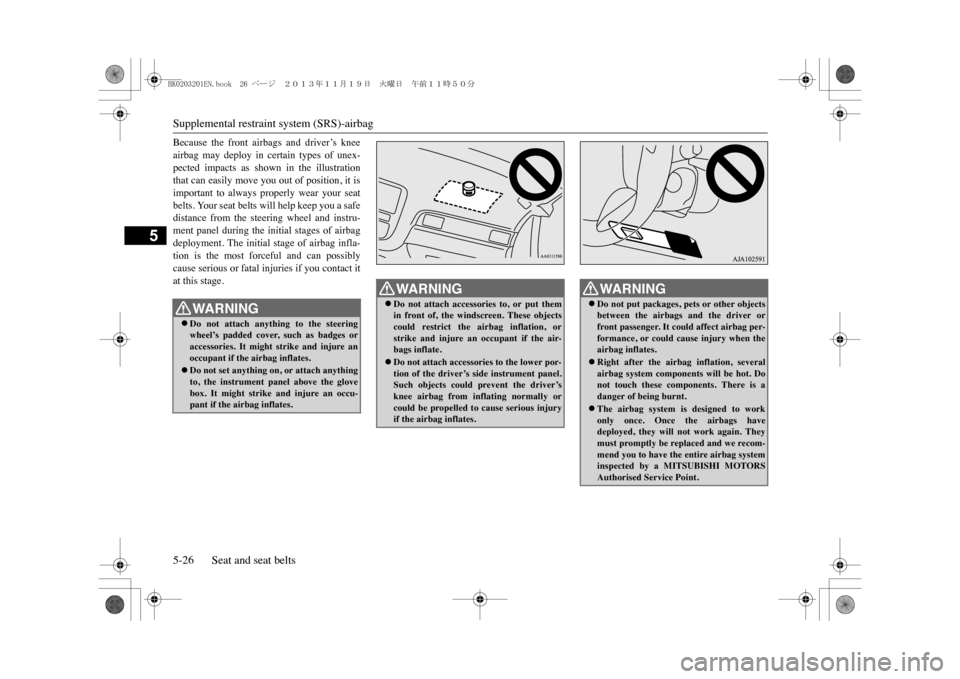
Supplemental restrain
t system (SRS)-airbag
5-26 Seat and seat belts
5
Because the front airbags and driver’s kneeairbag may deploy in certain types of unex-pected impacts as shown in the illustrationthat can easily move you out of position, it isimportant to always properly wear your seatbelts. Your seat belts will help keep you a safedistance from the steering wheel and instru-ment panel during the initial stages of airbagdeployment. The initial stage of airbag infla-tion is the most forceful and can possiblycause serious or fatal injuries if you contact itat this stage.
WA R N I N G�zDo not attach anything to the steeringwheel’s padded cover, such as badges oraccessories. It might strike and injure anoccupant if the airbag inflates.�zDo not set anything on, or attach anythingto, the instrument
panel above the glove
box. It might strike and injure an occu-pant if the airbag inflates.
WA R N I N G�zDo not attach accessories to, or put themin front of, the windscreen. These objectscould restrict the airbag inflation, orstrike and injure an occupant if the air-bags inflate.�zDo not attach accessories to the lower por-tion of the driver’s side instrument panel.Such objects could prevent the driver’sknee airbag from infl
ating normally or
could be propelled to cause serious injuryif the airb
ag inflates.
WA R N I N G�zDo not put packages, pets or other objectsbetween the airbags
and the driver or
front passenger. It could affect airbag per-formance, or could cause injury when theairbag inflates.�zRight after the airbag inflation, severalairbag system components will be hot. Donot touch these components. There is adanger of being burnt.�zThe airbag system is designed to workonly once. Once
the airbags have
deployed, they will not work again. Theymust promptly be replaced and we recom-mend you to have the entire airbag systeminspected by a MITSUBISHI MOTORSAuthorised Service Point.
BK0203201EN.book 26 ページ 2013年11月19日 火曜日 午前11時50分
Page 106 of 388
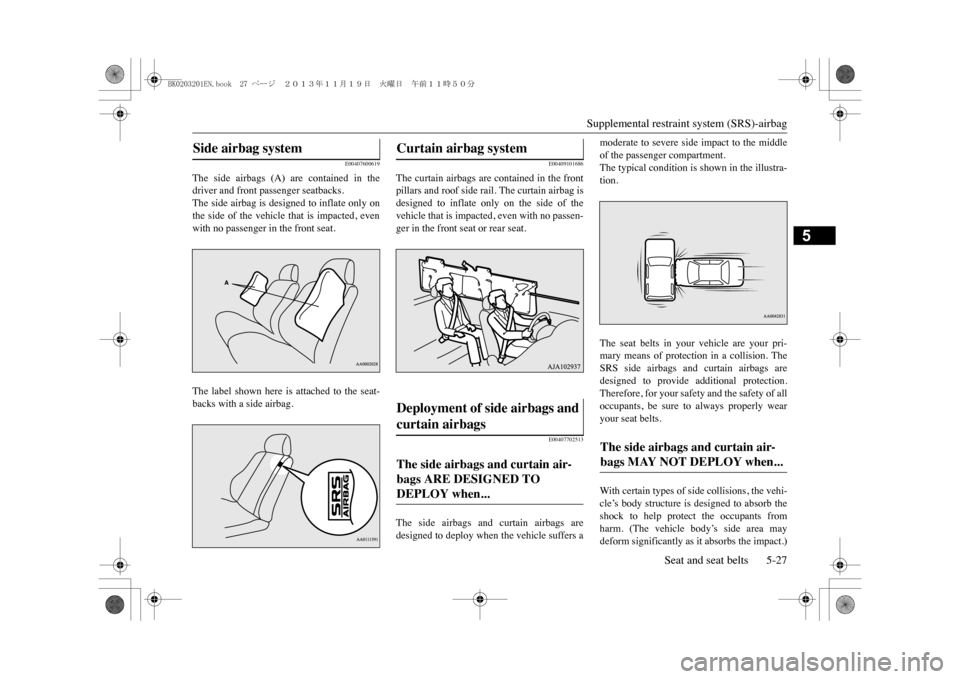
Supplemental restraint system (SRS)-airbag
Seat and seat belts 5-27
5
E00407600619
The side airbags (A) are contained in thedriver and front passenger seatbacks.The side airbag is designed to inflate only onthe side of the vehicle that is impacted, evenwith no passenger in the front seat.The label shown here is attached to the seat-backs with a side airbag.
E00409101686
The curtain airbags are contained in the frontpillars and roof side rail. The curtain airbag isdesigned to inflate only on the side of thevehicle that is impacted, even with no passen-ger in the front seat or rear seat.
E00407702513
The side airbags and curtain airbags aredesigned to deploy when the vehicle suffers a
moderate to severe side impact to the middleof the passenger compartment.The typical condition is shown in the illustra-tion.The seat belts in your vehicle are your pri-mary means of protection in a collision. TheSRS side airbags and curtain airbags aredesigned to provide additional protection.Therefore, for your safety and the safety of alloccupants, be sure to always properly wearyour seat belts.With certain types of side collisions, the vehi-cle’s body structure is designed to absorb theshock to help protect the occupants fromharm. (The vehicle body’s side area maydeform significantly as it absorbs the impact.)
Side airbag system
Curtain airbag system Deployment of side airbags and curtain airbags The side airbags and curtain air-bags ARE DESIGNED TO DEPLOY when...
The side airbags and curtain air-bags MAY NOT DEPLOY when...
BK0203201EN.book 27 ページ 2013年11月19日 火曜日 午前11時50分
Page 107 of 388
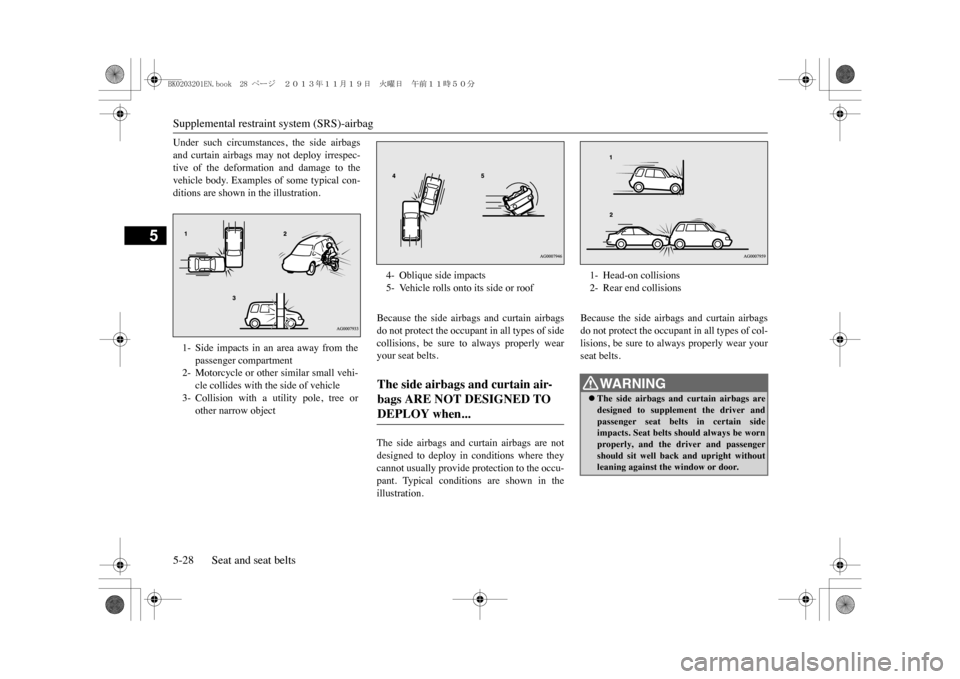
Supplemental restrain
t system (SRS)-airbag
5-28 Seat and seat belts
5
Under such circumstances, the side airbagsand curtain airbags may not deploy irrespec-tive of the deformation and damage to thevehicle body. Examples of some typical con-ditions are shown in the illustration.
Because the side airbags and curtain airbagsdo not protect the occupant in all types of sidecollisions, be sure to always properly wearyour seat belts.The side airbags and curtain airbags are notdesigned to deploy in conditions where theycannot usually provide protection to the occu-pant. Typical conditions are shown in theillustration.
Because the side airbags and curtain airbagsdo not protect the occupant in all types of col-lisions, be sure to always properly wear yourseat belts.
1- Side impacts in an area away from the
passenger compartment
2- Motorcycle or other similar small vehi-
cle collides with the side of vehicle
3- Collision with a utility pole, tree or
other narrow object
4- Oblique side impacts5- Vehicle rolls onto its side or roofThe side airbags and curtain air-bags ARE NOT DESIGNED TO DEPLOY when...
1- Head-on collisions2- Rear end collisionsWA R N I N G�zThe side airbags and curtain airbags aredesigned to supplement the driver andpassenger seat belts in certain sideimpacts. Seat belts should always be wornproperly, and the driver and passengershould sit well back and upright withoutleaning against the window or door.
BK0203201EN.book 28 ページ 2013年11月19日 火曜日 午前11時50分
Page 108 of 388
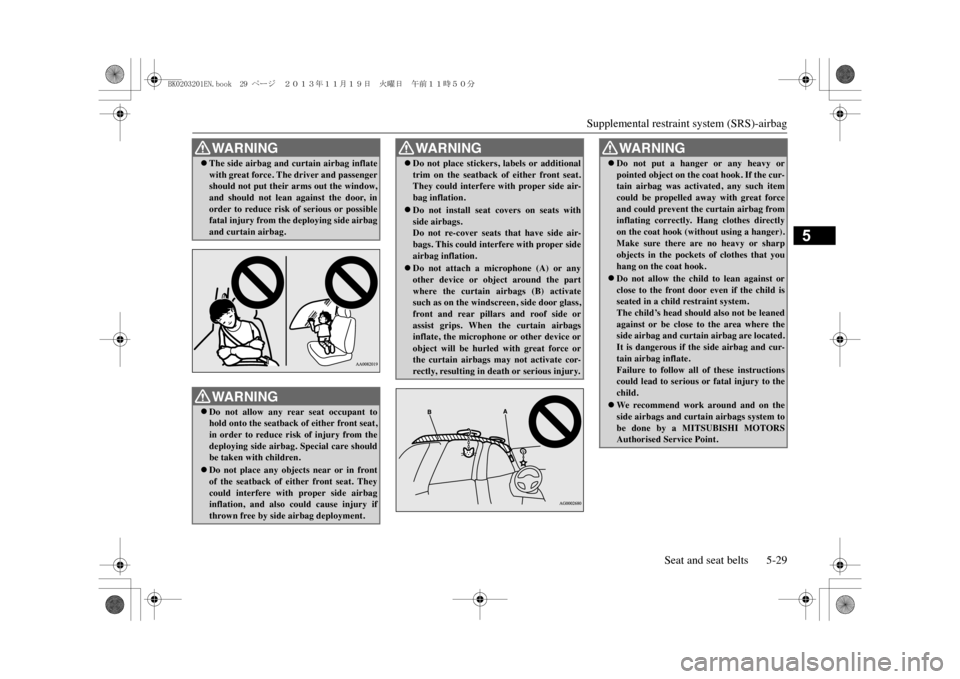
Supplemental restraint system (SRS)-airbag
Seat and seat belts 5-29
5
�zThe side airbag and cu
rtain airbag inflate
with great force. The driver and passengershould not put their arms out the window,and should not lean against the door, inorder to reduce risk of serious or possiblefatal injury from the
deploying side airbag
and curtain airbag.WA R N I N G�zDo not allow any rear seat occupant tohold onto the seatback
of either front seat,
in order to reduce risk of injury from thedeploying side airbag. Special care shouldbe taken with children.�zDo not place any objects near or in frontof the seatback of either front seat. Theycould interfere with proper side airbaginflation, and also could cause injury ifthrown free by side airbag deployment.WA R N I N G
�zDo not place stickers, labels or additionaltrim on the seatback of either front seat.They could interfere with proper side air-bag inflation.�zDo not install seat covers on seats withside airbags.Do not re-cover seats
that have side air-
bags. This could interfere with proper sideairbag inflation.�zDo not attach a microphone (A) or anyother device or object around the partwhere the curtain airbags (B) activatesuch as on the windsc
reen, side door glass,
front and rear pillars and roof side orassist grips. When
the curtain airbags
inflate, the microphone or other device orobject will be hurled with great force orthe curtain airbags may not activate cor-rectly, resulting in death or serious injury.WA R N I N G
WA R N I N G�zDo not put a hanger or any heavy orpointed object on the
coat hook. If the cur-
tain airbag was activated, any such itemcould be propelled away with great forceand could prevent the curtain airbag frominflating correctly. Hang clothes directlyon the coat hook (without using a hanger).Make sure there are no heavy or sharpobjects in the pockets of clothes that youhang on the coat hook.�zDo not allow the child
to lean against or
close to the front door even if the child isseated in a child restraint system.The child’s head should
also not be leaned
against or be close to the area where theside airbag and curtai
n airbag are located.
It is dangerous if the side airbag and cur-tain airbag inflate.Failure to follow all of these instructionscould lead to serious or fatal injury to thechild.�zWe rec ommend wor k around and on theside airbags and curtain airbags system tobe done by a MITSUBISHI MOTORSAuthorised Service Point.
BK0203201EN.book 29 ページ 2013年11月19日 火曜日 午前11時50分
Page 109 of 388
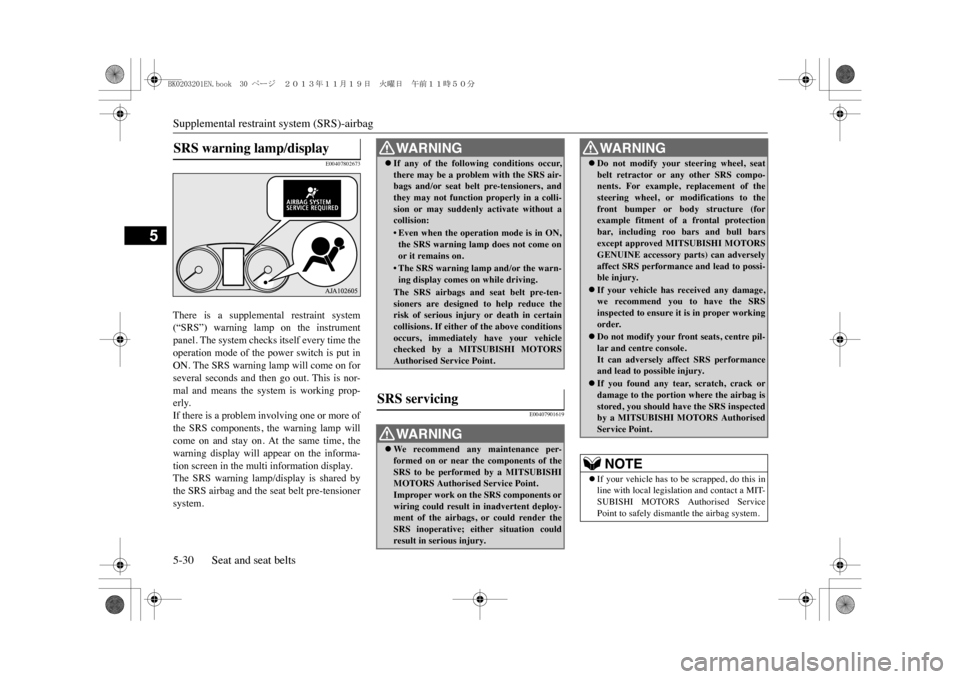
Supplemental restrain
t system (SRS)-airbag
5-30 Seat and seat belts
5
E00407802673
There is a supplemental restraint system(“SRS”) warning lamp on the instrumentpanel. The system checks itself every time theoperation mode of the power switch is put inON. The SRS warning lamp will come on forseveral seconds and then go out. This is nor-mal and means the system is working prop-erly.If there is a problem involving one or more ofthe SRS components, the warning lamp willcome on and stay on. At the same time, thewarning display will appear on the informa-tion screen in the mu
lti information display.
The SRS warning lamp/display is shared bythe SRS airbag and the seat belt pre-tensionersystem.
E00407901619
SRS warning lamp/display
WA R N I N G�zIf any of the following conditions occur,there may be a problem with the SRS air-bags and/or seat belt
pre-tensioners, and
they may not function
properly in a colli-
sion or may suddenly
activate without a
collision:•Even when the operation mode is in ON,the SRS warning lamp does not come onor it remains on.• The SRS warning lamp and/or the warn-ing display comes on while driving.The SRS airbags and seat belt pre-ten-sioners are designed to help reduce therisk of serious injury
or death in certain
collisions. If either of the above conditionsoccurs, immediately
have your vehicle
checked by a MITSUBISHI MOTORSAuthorised Service Point.
SRS servicing
WA R N I N G�zWe re commend any main tenanc e per-formed on or near the components of theSRS to be performed by a MITSUBISHIMOTORS Authorised Service Point.Improper work on the SRS components orwiring could result in inadvertent deploy-ment of the airbags,
or could render the
SRS inoperative; either situation couldresult in serious injury.
�zDo not modify your steering wheel, seatbelt retractor or any other SRS compo-nents. For example, replacement of thesteering wheel, or modifications to thefront bumper or body structure (forexample fitment of a frontal protectionbar, including roo bars and bull barsexcept approved MITSUBISHI MOTORSGENUINE accessory parts) can adverselyaffect SRS performance and lead to possi-ble injury.�zIf your vehicle has received any damage,we recommend you to have the SRSinspected to ensure it is in proper workingorder.�zDo not modify your front seats, centre pil-lar and centre console.It can adversely affect SRS performanceand lead to possible injury.�zIf you found any tear, scratch, crack ordamage to the portion where the airbag isstored, you should h
ave the SRS inspected
by a MITSUBISHI MOTORS AuthorisedService Point.NOTE
�zIf your vehicle has to be scrapped, do this inline with local legislation and contact a MIT-SUBISHI MOTORS Authorised ServicePoint to safely dismantle the airbag system.WA R N I N G
BK0203201EN.book 30 ページ 2013年11月19日 火曜日 午前11時50分
Page 110 of 388
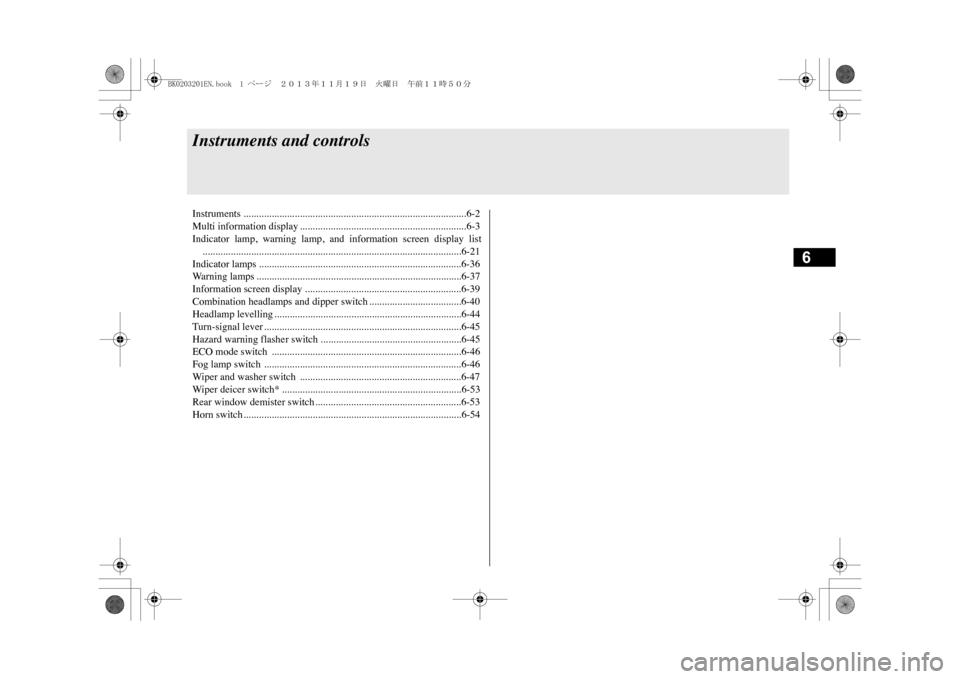
6
Instruments and controlsInstruments .......................................................................................6-2Multi information display ................................................................. 6-3Indicator lamp, warning lamp, and information screen display list.....................................................................................................6-21Indicator lamps ...............................................................................6-36Wa r n i n g l a m p s . . . . . . . . . . . . . . . . . . . . . . . . . . . . . . . . . . . . . . . . . . . . . . . . . . . . . . . . . . . . . . . . . . . . . . . . . . . . . . . . 6 - 3 7Information screen display .............................................................6-39Combination headlamps and dipper switch ....................................6-40Headlamp levelling .........................................................................6-44Turn-signal lever ............................................................................. 6-45Hazard warning flasher switch .......................................................6-45ECO mode switch ..........................................................................6-46Fog lamp switch .............................................................................6-46Wi p er and w ashe r sw it ch .. . . .. . .. . . .. . . .. . .. . . .. . . .. . .. . . .. . .. . . .. . . .. . .. . . .. . . .. . .. . . . 6- 4 7Wi p er dei ce r sw it ch * .. . .. . . .. . . .. . .. . . .. . . .. . .. . . .. . . .. . .. . . .. . .. . . .. . . .. . .. . . .. . . .. . .. . . . 6- 5 3Rear window demister switch.........................................................6-53Horn switch.....................................................................................6-54
BK0203201EN.book 1 ページ 2013年11月19日 火曜日 午前11時50分